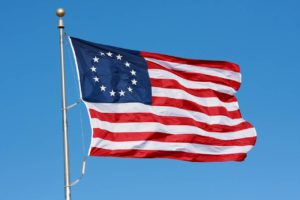Flag Day passes every year almost unnoticed. That’s a shame—it celebrates a symbol with ties to religious and totemic objects that have moved people for millennia

The Supreme Court declared in 1989 that desecrating the American flag is a protected form of free speech. That ended the legal debate but not the national one over how we should treat the flag. If anything, two years of controversies over athletes kneeling during “The Star-Spangled Banner,” which led last month to a National Football League ban on the practice, show that feelings are running higher than ever.
Yet, Flag Day—which honors the adoption of the Stars and Stripes by Congress on June 14, 1777—is passing by almost unnoticed this year, as it does almost every year. One reason is that Memorial Day and Independence Day—holidays of federally sanctioned free time, parades and spectacle—flank and overshadow it. That’s a shame, because we could use a day devoted to reflecting on our flag, a precious national symbol whose potency can be traced to the religious and totemic objects that have moved people for millennia.
The first flags were not pieces of cloth but metal or wooden standards affixed to poles. The Shahdad Standard, thought to be the oldest flag, hails from Persia and dates from around 2400 B.C. Because ancient societies considered standards to be conduits for the power and protection of the gods, an army always went into battle accompanied by priests bearing the kingdom’s religious emblems. Isaiah Chapter 49 includes the lines: “Thus saith the Lord God, Behold, I will lift up mine hand to the Gentiles, and set up my standard to the people.”
In succeeding centuries, the flag as we know it today began to take shape. Europeans and Arabs learned silk production, pioneered by China, which made it possible to create banners light enough to flutter in the wind. As in ancient days, they were most often designed with heraldic or religious motifs.
In the U.S., the design of the flag harked back to the Roman custom of an explicitly national symbol, but the Star-Spangled Banner was slow to attain its unique status, despite the popularity of Francis Scott Key’s 1814 anthem. It took the Civil War, with its dueling flags, to make the American flag an emblem of national consciousness. As the U.S. Navy moved to capture New Orleans from the Confederacy in 1862, Marines went ashore and raised the Stars and Stripes at the city’s mint. William Mumford, a local resident loyal to the Confederacy, tore the flag down and wore shreds of it in his buttonhole. U.S. General Benjamin Butler had Mumford arrested and executed.
After the war, the Stars and Stripes became a symbol of reconciliation. In 1867 Southerners welcomed Wisconsin war veteran Gilbert Bates as he carried the flag 1,400 miles across the South to show that the nation was healing.
As the country developed economically, a new peril lay in store for the Stars and Stripes: commercialization. The psychological and religious forces that had once made flags sacred began to fade, and the national banner was recruited for the new industry of mass advertising. Companies of the late 19th century used it to sell everything from beer to skin cream, leading to national debates over what the flag stood for and how it should be treated.





